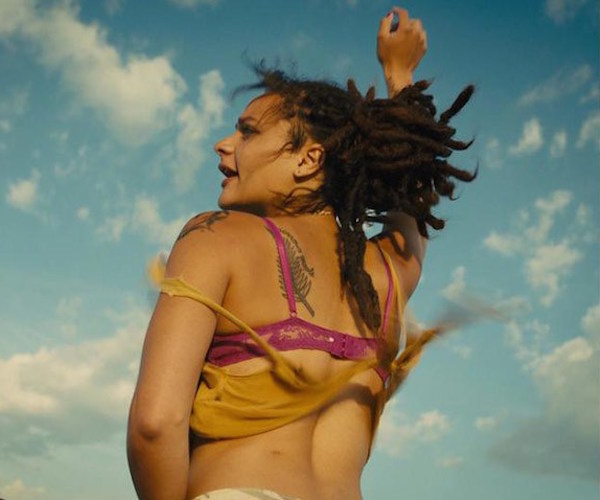Film Preview: Sasha Lane on the Heroic Honesty of “American Honey”
“It was really hard to get to certain places and bring up memories and experiences and put that out there. It helps me to think that I was representing a lot of people and different things.”

A scene from “American Honey.”
By Tim Jackson
British director Andrea Arnold’s approach to film treads a thin line between fiction and reality. She often makes use of improvisation, exploring the lives of marginalized working class kids by casting non-professional young performers. She has won three consecutive Cannes Jury Awards. Red Road (2006) was shot largely under Dogme 95 rules of austerity: authentic locations, hand-held cameras, no special lighting, with no extraneous action. Fish Tank (2009) presented casting discovery Katie Jarvis as a rebellious 15 year-old living in British Public Housing. Arnold’s direction elicited a strong performance from Jarvis, who met the challenge of being convincing in a highly charged storyline that revolved around an affair with an older man played by the estimable Michael Fassbender.
Arnold’s new film, American Honey (opening today at Kendall Square Cinema and AMC Loews Boston Common 19), explores the lives of disenfranchised American teenagers. Upping her customary ante, Arnold is using a crew of first time or novice actors working with a catch-and-catch-can script in a highly improvised style. “We never saw the whole script. We’d get the sides (the day’s shooting plan) that day,” recalls Sasha Lane, the young actress who plays Star, the 18-year old runaway who is at the center of the film. I spoke with Lane, now 21 years old, while she was in town for an early screening sponsored by the Independent Film Festival of Boston.
American Honey‘s skeletal story: One evening, seduced by a charming Shia LaBeouf (as Jake), Star leaves her little brother and sister with their mother at a line dance and hightails it to join a wild pack of rowdy teenagers who travel together selling magazines door to door across the South and Midwest.
For Star, the move is logical: home is a dead end. When we meet her she is rifling through a dumpster with her siblings for food. Running with a new crew has all the promise of a job with the circus. But it turns out that their salesmanship comes a distant second to drinking, drug use, and dead end sexuality. Star is both willful and disarmingly naïve. She does things her own way and speaks her mind. She butts heads with Krystal, the head of the petty organization, who is played with redneck sexiness by Riley Keough (excellent as the brazen Christine in the STARZ series The Girlfriend Experience). Star finds fleeting romance and puts herself at risk to show she can beat the hustle and make some real cash.
Of course, the story is secondary to the exploration of Sasha’s rite of passage. Arnold finds metaphors though examinations of natural details: moths, fireflies, spiders and, at one point, a grizzly bear.
“They didn’t tell me I would be doing a scene with that bear until the day we shot it” says Lane. The idea has nothing to do with suggesting the power of nature; the director often closes off the film frame to avoid the open landscapes of the typical American road movie. Instead, her foreigner’s eye favors America’s beaten-up spaces: malls and cheap hotels, dead-end areas lit up at night by fires flaring up from oil rigs. Though it all there is Star’s wondering gaze at a new world opening up before her. Lane is on screen nearly the entire time, often in close-up. We see experience through her eyes.
Despite that sense of discovery, the tone of the film wavers between danger and optimism. Palpable intimations of sexual threat can be felt in many of Lane’s scenes. The actress remembers what it was like: “There was a natural fear. It was a natural thing. It also made me look at myself and think ‘Sasha, that person who seems scary can be sweet in a weird way.’.That’s kind of the point. They think they [the male characters in the scenes] are using me – but I have a purpose. I’m here to get this done. It’s a transaction.”

Sasha Lane, star of “American Honey.”
Lane’s commitment to the reality of each day’s new situation meant that it took time to move from the role of ‘Star’ back to Sasha: “I am very, very empathetic. I listen to what’s around me. I have a love for people and all of that just fed into it. I go to these places and push out an energy across the screen because I feel everything so hard. Andrea sees that and it makes you feel really good about yourself.”
Arnold’s distinctive gift as a director is her ability find expressive novice performers and develop a relationship with them that strengthens their confidence at being themselves under ‘fictional’ circumstances. Did the cast members party as hard as it appears in certain scenes? Lane is mum. It’s all “a process and a commitment,” she explains. As for what it was like for the rest of the cast to return to the “real” world, she says a few continue to explore acting, but most are fine with returning to their lives beyond the experience of the film. “Everybody is very unapologetic and just themselves. This was an experience – but they’ll go back to what they do. They have their little families they’ve created. They’ll have a beer, they have their porch, their truck, whatever they love and they’re good. They’re good.”
Like her character, Lane is calm, strong, and level headed about the critical attention she is receiving for her bold performance. “I wasn’t trying to pursue [acting]. But I do think everything has a purpose. I do think this was meant to happen and meant to be,” she admits. “I don’t even think ‘Oh, lucky me.’ There was no other option.” Despite the storyline’s party atmosphere, she explains, “it was way more emotionally exhausting and scary than it shows.”
Arnold sees film-making as a quest: a means to catch the soul of characters who are not always represented honestly on the screen. Improvisation is not a short-cut to reach that end; it is used to strip the performers down to their emotional core: “We had to be very vulnerable. It was really hard to get to certain places and bring up memories and experiences and put that out there. It helps me to think that I was representing a lot of people and different things. Andrea knows. There is a trust, a connection and a purpose.
Tim Jackson was an assistant professor of Digital Film and Video for 20 years. His music career in Boston began in the 1970s and includes some 20 groups, recordings, national and international tours, and contributions to film soundtracks. He studied theater and English as an undergraduate, and has also has worked helter skelter as an actor and member of SAG and AFTRA since the 1980s. He has directed three feature documentaries: Chaos and Order: Making American Theater about the American Repertory Theater; Radical Jesters, which profiles the practices of 11 interventionist artists and agit-prop performance groups; When Things Go Wrong: The Robin Lane Story, and the short film The American Gurner. He is a member of the Boston Society of Film Critics. You can read more of his work on his blog.
